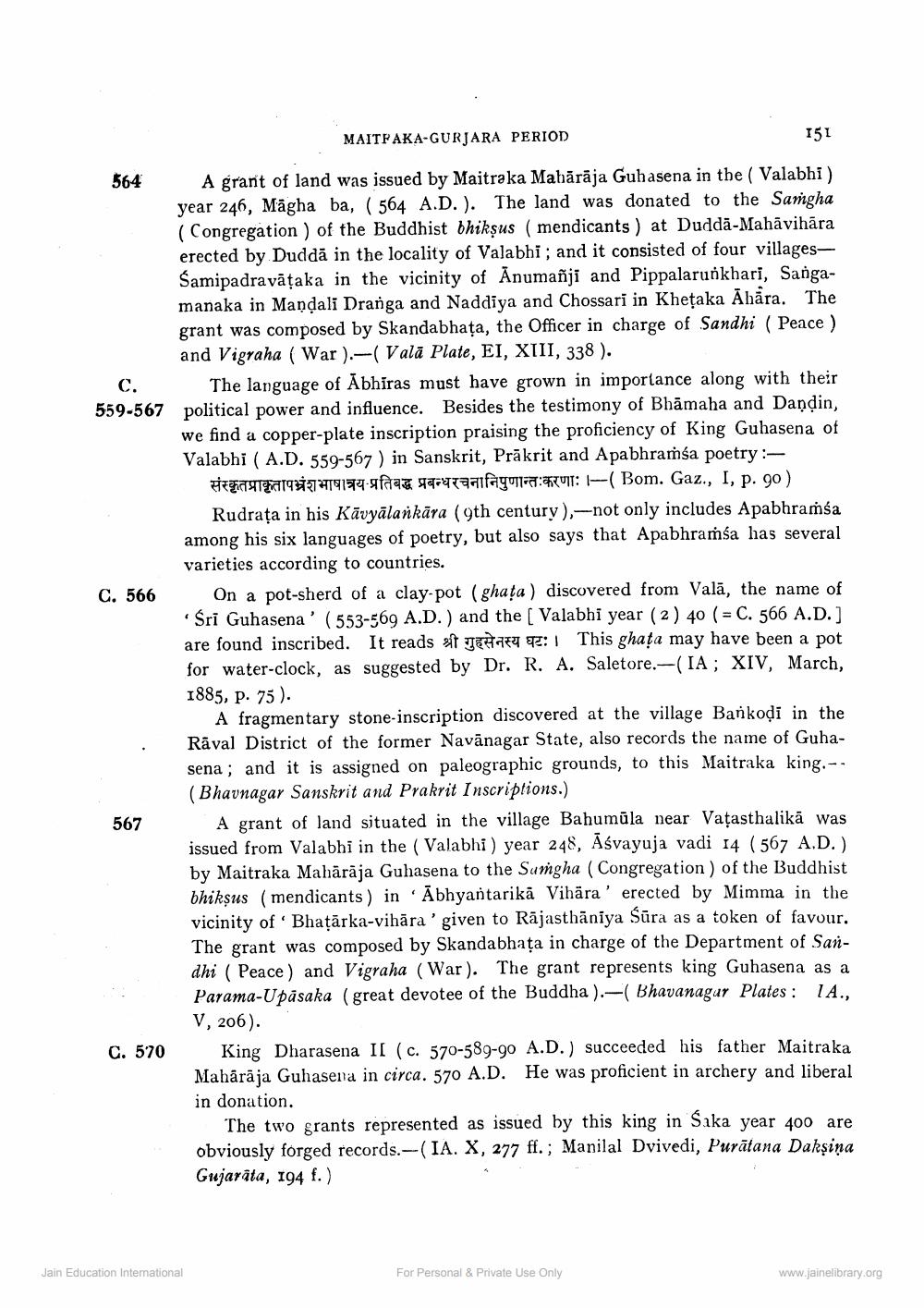________________
564
MAITPAKA-GURJARA PERIOD
151 A grant of land was issued by Maitraka Mahārāja Guhasena in the ( Valabhi) year 246, Māgha ba, ( 564 A.D.). The land was donated to the Sangha ( Congregation) of the Buddhist bhikṣus (mendicants) at Duddā-Mahāvihāra erected by Dudda in the locality of Valabhi; and it consisted of four villagesSamipadravāțaka in the vicinity of Anumañji and Pippalarunkhari, Sangamanaka in Mandali Dranga and Naddiya and Chossari in Khețaka Āhära. The grant was composed by Skandabhața, the Officer in charge of Sandhi ( Peace ) and Vigraha (War).- Valā Plate, EI, XIII, 338 ).
The language of Ābhiras must have grown in importance along with their 559-567 political power and influence. Besides the testimony of Bhāmaha and Dandin,
we find a copper-plate inscription praising the proficiency of King Guhasena of Valabhi ( A.D. 559-567 ) in Sanskrit, Prākrit and Apabhramśa poetry :
TEATTY#373191974-4fa4 ealfagoria:CUIT: 1-(Bom. Gaz., I, p. 90) Rudrata in his Kāvyālankāra (9th century),--not only includes Apabhramsa among his six languages of poetry, but also says that Apabhraíśa has several
varieties according to countries. C. 566 On a pot-sherd of a clay-pot (ghața ) discovered from Valā, the name of
Śri Guhasena' (553-569 A.D.) and the ( Valabhi year (2) 40 ( = C. 566 A.D.] are found inscribed. It reads sit Jahatu : This ghața may have been a pot for water-clock, as suggested by Dr. R. A. Saletore.-(IA; XIV, March, 1885, p. 75).
A fragmentary stone-inscription discovered at the village Bankodi in the Rāval District of the former Navānagar State, also records the name of Guhasena; and it is assigned on paleographic grounds, to this Maitraka king.--
(Bhavnagar Sanskrit and Prakrit Inscriptions.) 567 A grant of land situated in the village Bahumūla near Vațasthalika was
issued from Valabhi in the ( Valabhi) year 248, Āśvayuja vadi 14 ( 567 A.D.) by Maitraka Mahārāja Guhasena to the Sumgha ( Congregation) of the Buddhist bhikṣus (mendicants) in Abhyantarikā Vihära' erected by Mimma in the vicinity of Bhatārka-vihāra'given to Rājasthāniya Śūra as a token of favour. The grant was composed by Skandabhata in charge of the Department of Sandhi ( Peace) and Vigraha (War). The grant represents king Guhasena as a Parama-Upasaka (great devotee of the Buddha ).- ( Bhavanagar Plates: 1A.,
V, 206). C. 570 King Dharasena II (c. 570-589-90 A.D.) succeeded his father Maitraka
Mahārāja Guhasena in circa. 570 A.D. He was proficient in archery and liberal in donation.
The two grants represented as issued by this king in Saka year 400 are obviously forged records.--(IA. X, 277 ff.; Manilal Dvivedi, Purātana Daksina Gujarata, 194 f.)
Jain Education Interational
For Personal & Private Use Only
www.jainelibrary.org




